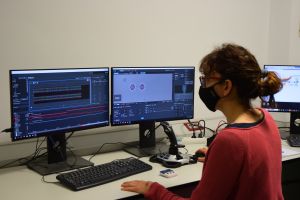Para comprender la actividad de esta proteína reparadora, los investigadores han empleado ensayos bioquímicos combinados con la tecnología de pinzas ópticas. Este instrumento óptico, ganador del Premio Nobel de Física en 2018, utiliza un rayo láser para sostener y mover físicamente objetos microscópicos. En el campo de la biomedicina se utiliza para manipular moléculas como el ADN y estudiar qué ocurre cuando esta interacciona con las proteínas.
Una helicasa capaz de retirar proteínas a su paso
En su estudio, los investigadores del Centro Nacional de Biotecnología (CNB-CSIC) observaron que HELB presenta algunas cualidades sorprendentes: “Esta helicasa es capaz de desplazarse retirando a su paso a RPA, una proteína encargada de recubrir y proteger el ADN”, comenta la investigadora del CNB-CSIC Silvia Hormeño.
Hasta ahora se creía que la función de la proteína RPA, siempre presente en el núcleo celular, era proteger el ADN y dar estabilidad a la cadena sencilla. Los investigadores creen que también podría actuar como señal encargada de indicar a otras proteínas daños que se presenten en el ADN. Sin embargo, para muchas proteínas es difícil actuar sobre el ADN en presencia de RPA, de ahí la importancia de HELB: “El hecho de que esta helicasa retire a su paso a RPA facilitaría que otras proteínas como RAD51 se unan a la cadena sencilla y lleven a cabo procesos vitales como la reparación del ADN”, destaca Hormeño.

Imagen obtenida con el equipo C-Trap (pinzas ópticas) de una molécula de ADN cubierta por la proteína HELB (en azul) retirando la proteína RPA (en verde). Silvia Hormeño, CNB-CSIC
Lazos que facilitan la cadena sencilla
El equipo del CNB-CSIC, dirigido por Fernando Moreno-Herrero en colaboración con el grupo de Mark S. Dillingham, de la Universidad de Bristol, ha descubierto que HELB tiene además la capacidad de hacer lazos (loops, en inglés) de cadena sencilla de ADN. Esta característica, que se ha encontrado recientemente en otras helicasas, es una herramienta que ayuda a mejorar la abertura de la doble hélice manteniendo las dos cadenas alejadas entre ellas.
“Este tipo de características mecánicas de una proteína solo se pueden estudiar empleando técnicas biofísicas que interroguen cada molécula de forma individual”, comenta Moreno-Herrero. Para lograrlo, los investigadores emplean la tecnología de pinzas ópticas: mediante trampas formadas por lentes capturan pequeñas esferas de plástico e inmovilizan una molécula de ADN entre las dos esferas. Además, los investigadores utilizan fluorescencia para ver las proteínas que actúan sobre el ADN y estudiar su comportamiento.
“Gracias a que en el CNB contamos con el único instrumento de pinzas ópticas con fluorescencia confocal que hay en España (C-Trap, de Lumicks) somos capaces de estudiar la dinámica de estas proteínas que interaccionan sobre el ADN en tiempo real y con una visualización directa”, concluye el líder del grupo en el CNB.
Más información
Silvia Hormeño, Oliver J Wilkinson, Clara Aicart-Ramos, Sahiti Kuppa, Edwin Antony, Mark S. Dillingham, and Fernando Moreno-Herrero. Human HELB is a processive motor protein that catalyzes RPA clearance from single-stranded DNA. PNAS 2022; 119 (15) e2112376119 DOI: https://doi.org/10.1073/pnas.2112376119
CNB-CSIC Comunicación y Lucía Casas / Contenido realizado dentro del Programa de Ayudas CSIC – Fundación BBVA de Comunicación Científica, Convocatoria 2021






